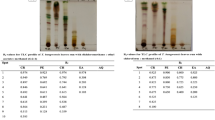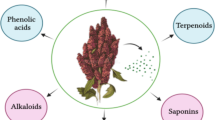Abstract
This study was undertaken with an objective of testing the antibacterial and antifungal activities of Bauhinia purpurea leaves and identifying the bioactive compounds. The antimicrobial activity of leaf extract was determined in aqueous and organic extracts and the minimum inhibitory concentration (MIC) against six species of pathogenic and non-pathogenic microorganisms: Bacillus subtilis, Staphylococcus aureus, Salmonella typhi, Escherichia coli, Pseudomonas aeruginosa and Candida albicans using the disk diffusion method. The chemical constituents of organic plant extract were separated by thin layer chromatography and purified by column chromatography and further identified by gas chromatography–mass spectrometry (GC–MS) analysis. Significant inhibitory activity was observed with methanol extracts of plant against the test microorganisms while less antibacterial activity was observed in hexane, acetone and aqueous extracts. MIC of B. purpurea extract was ≤1,500 μg/ml against S. aureus and B. subtilis while this extract showed no inhibition against Gram-negative S. typhi, E. coli and P. aeruginosa or against fungus C. albicans. Eleven compounds were identified in B. purpurea leaf extract by GC–MS analysis. The composition of B. purpurea revealed the presence of lupeol, stigmasterol, lanosterol, ergosterol, beta-tocopherol, phytol, hexadeconic acids, hexadeconic acids methyl esters, octadecadienoic acids and octadecatrienoic acid. Stigmasterol and lupeol were the most abundant (34.48 and 15.63 %). Other phytosterols like lanosterol (4.15 %) and ergosterol (2.82 %) were also found to be present in this extract.
Similar content being viewed by others
References
Copp BR (2003) Antimycobacterial natural products. Nat Prod Rep 20:535–557
Kaushik P, Dhiman AK (2000) Medicinal plants and raw drugs of india. Bishen Singh Mahendra Pal Singh, New Cannaught Place
Kim IG, Kang SC, Kim KC, Choung ES, Zee OP (2008) Screening of estrogenic and antiestrogenic activities from medicinal plants. Environ Toxicol Pharmacol 25(1):75–82
Yadava RN, Tripathi P (2000) A novel flavone glycoside from the stem of Bauhinia purpurea. Fitoterapia 71(1):88–90
Pettit GR, Numata A, Iwamoto C, Usami Y, Yamada T, Ohishi H (2006) Isolation and structures of Bauhinia statins 1–4 from Bauhinia purpurea. J Nat Prod 69:323–327
Wu AM, Wu JH, Jia-Hua Liu, Tanuja S (2004) Recognition profile of Bauhinia purpurea agglutinin (BPA). Life Sci 74(14):1763–1779
Sarkar AB, Akagi T, Yoshino T, Fujiwara K, Murakami I (1993) Bauhinia purpurea lectin (BPA) binding spectra in hyperplastic human tonsil and in peripheral blood: immonohistochemical, immunoelectron microscopic and flow cytometric analysis. J Histochem Cytochem 41(6):67–72
Sarkar AB, Akagi T, Jeon HJ, Miyake K, Murakami I, Yoshino T, Takahashi K, Nose S (1992) Bauhinia purpurea—a new paraffin section marker for Reed–Sternberg cells of Hodgkin’s disease. A comparison with Liu-M1 (CD15), LN2 (CD74), peanut agglutinin and Ber-H2 (CD30). Am J Pathol 141:19–23
Smith P, Douglas I, McMurray J, Carroll C (2009) A rapid method of improving the criteria being used to interpret disc diffusion antimicrobial susceptibility test data for bacteria associated with fish diseases. Aquaculture 290(1–2):172–178
Clinical and Laboratory Standards Institute CLSI (2005) Methods for dilution antimicrobial susceptibility tests for bacteria that grow aerobically, 6th edn.: approved standard M7-A6 CLSI. Wayne, Pennsylvania
Clinical and Laboratory Standards Institute CLSI (2008) Reference method for broth dilution antifungal susceptibility testing of yeasts: approved standard, 3rd edn. M27-A3 CLSI, Wayne, Pennsylvania
Nostro A, Germano MP, Angelo VD, Marino A, Canatelli MA (2000) Extraction methods and bioautography for evaluation of medicinal plant antimicrobial activity. Lett Appl Microbiol 30:384–397
Parekh J, Jadeja D, Chanda S (2005) Efficacy of aqueous and methanol extracts of some medicinal plants for potential antibacterial activity. Turk J Biol 29:203–210
Neto MM, Neto MA, Filho RB, Lima MAS, Silveira ER (2008) Flavonoids and alkaloids from leaves of Bauhinia ungulata L. Biochem Syst Ecol 36(3):227–229
Burt S (2004) Essential oils: their antibacterial properties and potential applications in foods—a review. Int J Food Microbiol 94:223–253
Runyoro DKB, Matee MIN, Ngassapa OD, Joseph CC, Mbwambo ZH (2006) Screening of Tanzanian medicinal plants for anti-candida activity. BMC Complement Altern Med 6(11):1186–1472
Vardar-Unlu G, Silici S, Unlu M (2008) Composition and in vitro antimicrobial activity of Populus buds and poplar-type propolis. World J Microbiol Biotechnol 24:1011–1017
Ragasa CY, Hofilena J, Rideout JA (2004) Secondary metabolite from Bauhinia purpurea. Ind J Microbiol 133(1):1–5
Mikamo E, Okada Y, Semma M, Ito Y, Morimoto T, Nakamura M (2000) Studies on structural correlation with antioxidant activity of flavonoids. Jpn Soc Food Chem 7(2):93–97
Chambers HF, Merle AS (1996) Antimicrobial agents—general considerations. In: Joel GH, Lee EL (eds) Goodman and Gilman’s the pharmacological basis of therapeutic, 9th edn. McGraw-Hill, Medical Publishing Division, New York
Iwu MW, Duncan AR, Okunji CO (1999) New antimicrobials of plant origin. In: Janick J (ed) Perspectives on new crops and new uses. ASHS Press, Alexandria, pp 457–462
Acknowledgments
The authors express sincere and heartfelt thanks to Central Salt and Marine Research Institute (CSMRI) for carrying out GC–MS analysis.
Author information
Authors and Affiliations
Corresponding author
Rights and permissions
About this article
Cite this article
Negi, B.S., Dave, B.P. & Agarwal, Y.K. Evaluation of Antimicrobial Activity of Bauhinia purpurea Leaves Under In Vitro Conditions. Indian J Microbiol 52, 360–365 (2012). https://doi.org/10.1007/s12088-012-0264-0
Received:
Accepted:
Published:
Issue Date:
DOI: https://doi.org/10.1007/s12088-012-0264-0




